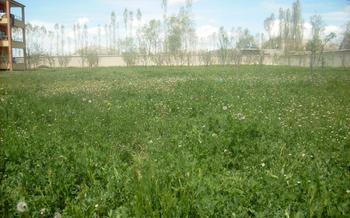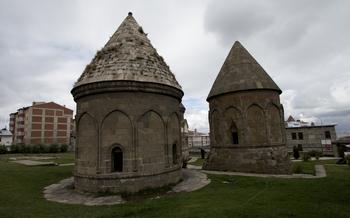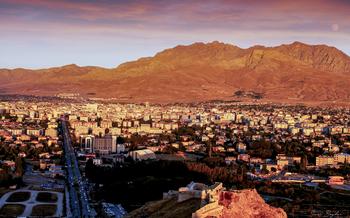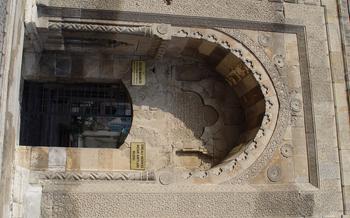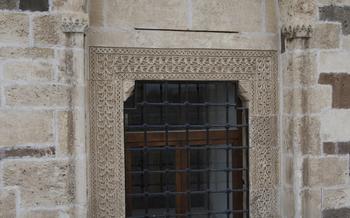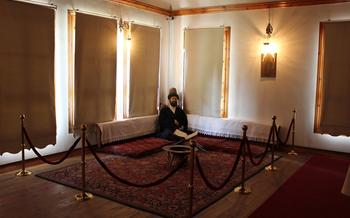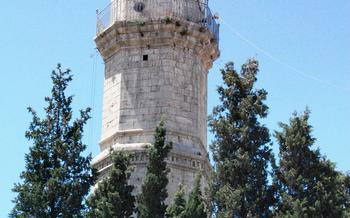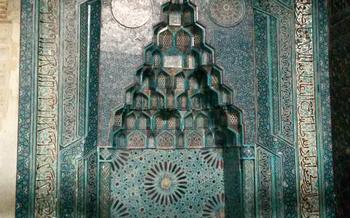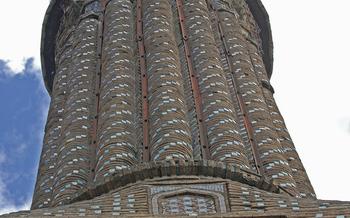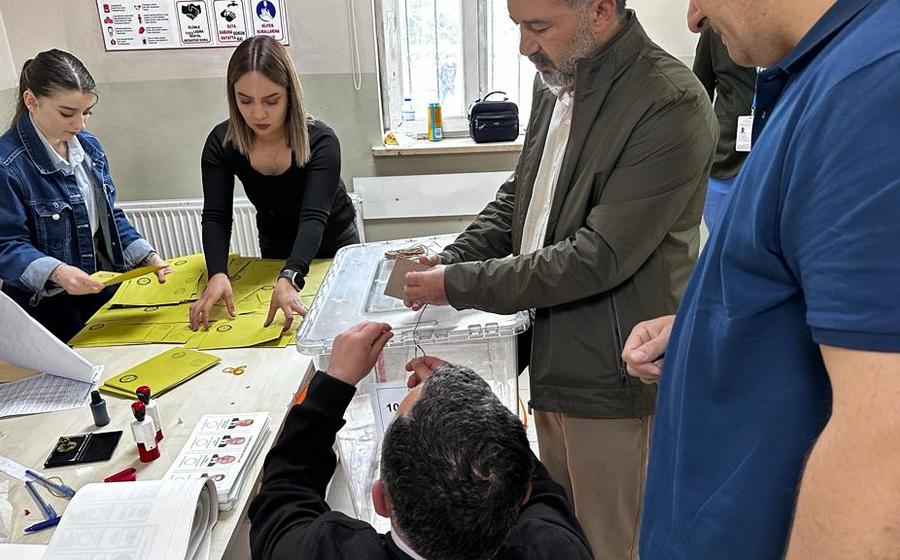
Büyük Mescid and Yağbasan Medrese
- History of the Büyük Mescid and Yağbasan Medrese
- Location of the Büyük Mescid and Yağbasan Medrese
- Visiting the Büyük Mescid and Yağbasan Medrese
- Exploring the Büyük Mescid
- Exploring the Yağbasan Medrese
- The Seljuk Architecture of the Complex
- The Role of the Complex in Islamic Education
- The Complex as a Cultural Heritage Site
- Local Traditions and Customs
- Practical Tips for Visitors
- Photography and Videography
- Accessibility for People with Disabilities
- Educational Programs and Workshops
- Souvenirs and Handicrafts
- Insider Tip: Experience the Mevlid-i Nebi Celebration
History of the Büyük Mescid and Yağbasan Medrese
The Büyük Mescid and Yağbasan Medrese are two of the most significant historical landmarks in Van, Turkey. They were built during the Seljuk period, which lasted from the 11th to the 13th century. During this time, Van was a major center of Islamic learning and culture. The Seljuks were a Turkish dynasty that ruled over a vast empire that stretched from Central Asia to Anatolia. They were known for their patronage of the arts and sciences, and they built many mosques, madrasas, and other religious buildings throughout their empire.
The Büyük Mescid, which means "Great Mosque," was built in 1168 by the Seljuk sultan, Rukn al-Din Arslan Shah. It is one of the largest mosques in Turkey and can accommodate up to 10,000 worshippers. The Yağbasan Medrese, which means "Yağbasan Theological School," was built in 1271 by the Seljuk vizier, Shams al-Din Isfahani. It was one of the most important centers of Islamic education in Anatolia and produced many renowned scholars and theologians.
Both the Büyük Mescid and Yağbasan Medrese are fine examples of Seljuk architecture. They are built of stone and brick and feature intricate carvings and decorations. The buildings are also a testament to the Seljuks' commitment to Islamic learning and education.
Location of the Büyük Mescid and Yağbasan Medrese
The Büyük Mescid and Yağbasan Medrese are located in the heart of Van, a city in eastern Turkey. The complex is situated on Kazım Karabekir Street, within the Van Kalesi neighborhood. To reach the complex, visitors can take a taxi or rent a car from the city center. The journey takes approximately 15 minutes.
The Büyük Mescid and Yağbasan Medrese are surrounded by several historical landmarks, including the Van Fortress, the Van Museum, and the Van Armenian Church. Visitors can explore these attractions before or after visiting the complex.
The complex is easily accessible for tourists. The streets are well-maintained, and there are clear signs and directions leading to the site. There are also several restaurants and cafes in the vicinity where visitors can enjoy a meal or a cup of coffee.
Visiting the Büyük Mescid and Yağbasan Medrese
The Büyük Mescid and Yağbasan Medrese are open to the public from 9:00 AM to 5:00 PM daily, except during prayer times. Admission is free of charge. Guided tours are available in English, Turkish, and Arabic upon request and offer a deeper insight into the history and significance of the complex. For those who prefer to explore at their own pace, self-guided tours are also welcome, with information panels and brochures provided to enhance your experience.
To capture the essence of the complex, consider arriving early in the morning or late in the afternoon when the light is most flattering. Photography and videography are permitted, but using a tripod or flash is prohibited to protect the delicate interiors. Drones and other flying devices are not allowed due to safety and privacy concerns.
Exploring the Büyük Mescid
The Büyük Mescid is the heart of the complex, a stunning testament to Seljuk architectural prowess. Step inside the prayer hall, and you'll be awed by its sheer size and grandeur. The towering columns, intricate arches, and elegant domes create a sense of awe and reverence. The mihrab, the prayer niche indicating the direction of Mecca, is a masterpiece of artistry, adorned with intricate carvings and colorful tiles.
The minbar, the pulpit from which the imam delivers his sermons, is another highlight, showcasing fine craftsmanship and attention to detail. Outside, in the courtyard, stands an ablution fountain, where worshippers cleanse themselves before prayers, adding a touch of serenity to the surroundings.
Exploring the Yağbasan Medrese
The Yağbasan Medrese, also known as the Yağbasan Madrasah, is a former Islamic seminary and school located adjacent to the Büyük Mescid. It was constructed concurrently with the mosque and served as a center of Islamic learning and scholarship during the Seljuk period. The medrese comprises several classrooms, a library, student dormitories, a kitchen, and a courtyard.
The classrooms, or dershane, are spacious and well-lit, featuring intricate carvings and decorations. The library, or kütüphane, houses an impressive collection of Islamic texts, manuscripts, and rare books. The student dormitories, or hücre, are small, simple rooms where students resided during their studies. The kitchen, or matbah, provided meals for the students and staff.
The courtyard, or avlu, is a serene and peaceful space, featuring a central fountain for ablutions. It serves as a gathering place for students and scholars to socialize, study, and engage in discussions. The garden, or bahçe, adjacent to the courtyard offers a tranquil retreat for contemplation and reflection.
The Seljuk Architecture of the Complex
The Büyük Mescid and Yağbasan Medrese are remarkable examples of Seljuk architecture, which flourished in Anatolia from the 11th to the 13th century. The complex showcases the distinctive characteristics of Seljuk architecture, blending Islamic and Anatolian architectural elements.
The buildings are constructed primarily of stone and brick, with intricate carvings and decorations adorning the facades. The main entrance to the mosque features a stunning portal with elaborate carvings and inscriptions, exemplifying the Seljuk mastery of stonework.
The interiors of the buildings are equally impressive, with vaulted ceilings and arched doorways. The prayer hall of the mosque is supported by massive columns and features a mihrab, a niche indicating the direction of Mecca, which is intricately carved with geometric and floral motifs. The courtyard of the medrese is surrounded by a beautiful arcade, creating a serene and contemplative space for students and visitors alike.
The Seljuk architectural style is characterized by its combination of Islamic and Anatolian elements. The use of stone and brick, as well as the intricate carvings and decorations, reflect the influence of Islamic architecture. However, the incorporation of Anatolian elements, such as the use of vaults and arches, demonstrates the unique regional identity of Seljuk architecture.
The Büyük Mescid and Yağbasan Medrese stand as testaments to the architectural prowess of the Seljuks. Their intricate designs and harmonious blend of Islamic and Anatolian elements make them must-see destinations for anyone interested in Islamic history and architecture.
The Role of the Complex in Islamic Education
The Büyük Mescid and Yağbasan Medrese played a pivotal role in Islamic education during the Seljuk period. The medrese was established as a center for the teaching of Islamic law, theology, and other religious subjects. It attracted students from all over the region, who came to study under the tutelage of renowned scholars and theologians.
The curriculum at the medrese was comprehensive and rigorous, covering a wide range of Islamic disciplines. Students studied the Quran, hadith, Islamic law, and theology. They also received instruction in Arabic grammar, literature, and history. The medrese's library was well-stocked with books on a variety of subjects, providing students with access to a wealth of knowledge.
The medrese was not only a place of learning but also a center for the dissemination of Islamic knowledge. Graduates of the medrese went on to become religious leaders, teachers, and scholars. They played a key role in spreading Islamic knowledge and culture throughout the Seljuk Empire and beyond.
The Büyük Mescid and Yağbasan Medrese made a significant contribution to Islamic education and scholarship. It was one of the leading centers of Islamic learning in the Seljuk period, and its legacy continues to this day.
The Complex as a Cultural Heritage Site
The Büyük Mescid and Yağbasan Medrese complex is a testament to the rich cultural heritage of Turkey and the Islamic world. Its historical significance and architectural beauty have made it a valuable cultural heritage site, attracting visitors from around the globe. The complex is a reminder of the Seljuk period, a time of great cultural and intellectual advancement in the region.
Recognizing the importance of preserving this unique site, UNESCO designated the Büyük Mescid and Yağbasan Medrese as a World Heritage Site in 20This designation highlights the complex's outstanding universal value and ensures its protection for future generations.
Ongoing efforts are being made to conserve and maintain the complex, ensuring that its architectural integrity and historical significance are preserved. Balancing the preservation of the site with the needs of tourism is a challenge, but one that is being carefully managed to ensure the complex remains a source of inspiration and knowledge for visitors for years to come.
Local Traditions and Customs
The Büyük Mescid and Yağbasan Medrese are deeply intertwined with the local traditions and customs of Van. These historic structures serve as the heart of the city's religious and cultural life, playing a significant role in various festivals and celebrations. One of the most important events held at the complex is the annual Mevlid-i Nebi, commemorating the birth of Prophet Muhammad. During this celebration, the complex transforms into a lively gathering place, where locals come together to recite prayers, sing religious songs, and share in the joy of the occasion. Visitors to the complex can immerse themselves in this vibrant atmosphere, witnessing firsthand the deep devotion and reverence that the local community holds for their religious heritage. It is essential to approach these traditions with respect and understanding, observing local customs and dress codes to ensure a harmonious and enriching experience.
Practical Tips for Visitors
The best time to visit the Büyük Mescid and Yağbasan Medrese is during the spring or fall, when the weather is mild and pleasant. Avoid visiting during the summer months, as the heat can be oppressive.
When visiting the complex, be sure to dress respectfully. Women should cover their heads and shoulders, and men should wear long pants. It is also important to be mindful of the local customs and traditions, and to behave in a respectful manner.
There are several restaurants and cafes in the vicinity of the complex where you can grab a bite to eat or enjoy a cup of coffee. For a more authentic experience, try one of the local restaurants serving traditional Turkish cuisine.
If you are planning to stay overnight in Van, there are several hotels and guesthouses to choose from. There are also several hostels and budget hotels available for those on a tighter budget.
Photography and Videography
The Büyük Mescid and Yağbasan Medrese offer a wealth of opportunities for photography and videography. The intricate architecture, serene courtyards, and vibrant colors provide a picturesque backdrop for capturing stunning images. Here are some tips to help you make the most of your photography and videography experience:
-
Respect the sanctity of the site. Remember that the complex is an active place of worship, so be respectful of the worshippers and avoid taking photos or videos that may be disruptive.
-
Arrive early or late in the day. The complex is often less crowded during these times, which will give you the chance to capture photos and videos without the distraction of large crowds.
-
Use a tripod. A tripod will help you stabilize your camera and capture sharp, blur-free images.
-
Experiment with different angles and perspectives. Try shooting from different angles and perspectives to create unique and interesting shots.
-
Use natural light. The natural light in the complex is often beautiful, so try to use it to your advantage when taking photos or videos.
-
Be aware of the rules and regulations. Before taking any photos or videos, be sure to check the complex's rules and regulations to ensure that you are not violating any restrictions.
-
Share your work. Once you have captured some stunning photos or videos, be sure to share them with others. You can post them on social media, share them with your friends and family, or even submit them to a photography or videography contest.
Accessibility for People with Disabilities
The Büyük Mescid and Yağbasan Medrese strive to ensure accessibility for visitors with disabilities. Wheelchair ramps and accessible entrances are available at various points throughout the complex, allowing for easy navigation for those with limited mobility. To further enhance accessibility, the complex provides audio guides and other assistive devices for visitors with visual or hearing impairments. Designated parking spaces and restrooms are also available to ensure a comfortable and inclusive experience for all visitors. With these provisions in place, the complex aims to create an environment that welcomes and accommodates visitors from all abilities and backgrounds.
Educational Programs and Workshops
The Büyük Mescid and Yağbasan Medrese offer a variety of educational programs and workshops for students, researchers, and the general public. These programs provide an opportunity to delve deeper into the history, architecture, and religious significance of the complex.
Students and researchers can participate in workshops on Islamic history, architecture, and calligraphy. These workshops are led by experts in the field and provide hands-on experience with historical documents, artifacts, and techniques.
Internships and volunteer programs are also available for those who wish to gain practical experience in the field of Islamic heritage conservation. Interns and volunteers assist with research, restoration projects, and educational outreach initiatives.
Educational programs and workshops at the Büyük Mescid and Yağbasan Medrese are an excellent way to learn about Islamic history and culture while contributing to the preservation of this important heritage site.
Souvenirs and Handicrafts
After immersing yourself in the history and architecture of the Büyük Mescid and Yağbasan Medrese, don't forget to take a piece of the experience home with you. In the vicinity of the complex, you'll find an array of shops and stalls selling traditional souvenirs and handicrafts that reflect the rich cultural heritage of Van.
From intricately woven carpets and kilims to hand-painted ceramics and intricate jewelry, there's something to suit every taste and budget. Look out for unique souvenirs like miniature replicas of the Büyük Mescid, prayer beads made from local stones, or hand-embroidered textiles.
By purchasing these locally made crafts, you not only take home a tangible memory of your visit but also support the talented artisans and businesses that keep traditional skills alive. Whether you're looking for a gift for a loved one or a special memento for yourself, shopping for souvenirs around the Büyük Mescid and Yağbasan Medrese is a rewarding experience that allows you to contribute to the local economy and preserve the cultural heritage of this fascinating region.
Insider Tip: Experience the Mevlid-i Nebi Celebration
Immerse yourself in the spiritual and cultural significance of the Büyük Mescid and Yağbasan Medrese by attending the annual Mevlid-i Nebi celebration. This special event, commemorating the birth of the Prophet Muhammad, is a vibrant display of devotion and religious rituals.
During the celebration, the complex transforms into a hub of activity, with colorful decorations, traditional music, and a palpable sense of joy. Join the local community as they gather to recite prayers, listen to religious teachings, and pay tribute to the Prophet's life and legacy.
The Mevlid-i Nebi celebration offers a unique opportunity to witness the deep connection between the complex and the local culture. It's an unforgettable experience that allows visitors to gain a deeper understanding of Islamic traditions and the enduring legacy of the Büyük Mescid and Yağbasan Medrese.
